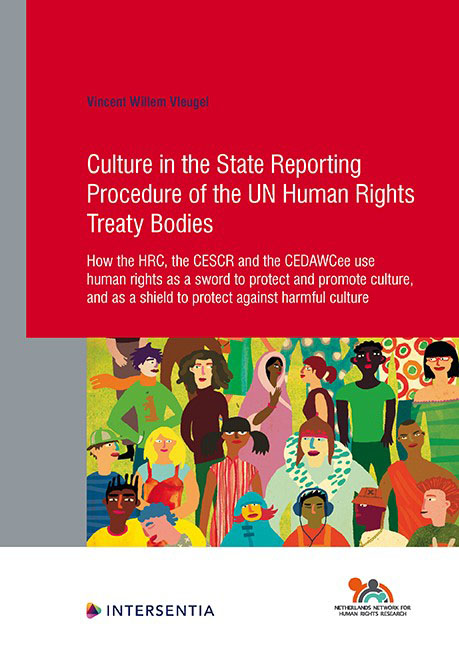 Culture in the State Reporting Procedure of the UN Human Rights Treaty Bodies
Culture in the State Reporting Procedure of the UN Human Rights Treaty Bodies Book contents
- Frontmatter
- Acknowledgements
- Contents
- Abbreviations
- Note on Citation Formats
- Note on Grammar
- Chapter 1 Introduction
- Chapter 2 Human Rights and Cultural Diversity. Between and Beyond Universalism and Cultural Relativism
- Chapter 3 UN Treaty Bodies. Treaties, Committees, Working Methods
- Chapter 4 Human Rights as a Sword. To Protect and Promote Cultural Diversity
- Chapter 5 Human Rights as a Shield. To Protect against Harmful Aspects of Culture
- Chapter 6 Cultural Argumentation. The State Reporting Procedure as a Platform for Cross-Cultural Dialogue
- Chapter 7 Conclusions. How the Treaty Bodies Universalise Human Rights
- Bibliography
- Summary
- Samenvatting
- Human Rights Research Series
Chapter 7 - Conclusions. How the Treaty Bodies Universalise Human Rights
Published online by Cambridge University Press: 11 November 2021
- Frontmatter
- Acknowledgements
- Contents
- Abbreviations
- Note on Citation Formats
- Note on Grammar
- Chapter 1 Introduction
- Chapter 2 Human Rights and Cultural Diversity. Between and Beyond Universalism and Cultural Relativism
- Chapter 3 UN Treaty Bodies. Treaties, Committees, Working Methods
- Chapter 4 Human Rights as a Sword. To Protect and Promote Cultural Diversity
- Chapter 5 Human Rights as a Shield. To Protect against Harmful Aspects of Culture
- Chapter 6 Cultural Argumentation. The State Reporting Procedure as a Platform for Cross-Cultural Dialogue
- Chapter 7 Conclusions. How the Treaty Bodies Universalise Human Rights
- Bibliography
- Summary
- Samenvatting
- Human Rights Research Series
Summary
INTRODUCTION
The overarching research objective of this study was to map and analyse the ways in which culture features in the UN treaty bodies’ State reporting procedure.
This research has taken place in a time of increasing challenges to the universality of human rights. According to the Special Rapporteur in the field of cultural rights at the time of writing, Karima Bennoune:
(…) universality is currently under sustained attack from many directions, including from some Governments, from some on the political right and left, from some non-State actors, including extremists, fundamentalists and populists around the world, and even from some quarters in academia, including those who misuse culture and cultural rights justifications.
This indicates a revival of the universalism versus cultural relativism debate, which has been ongoing ever since the adoption of the Universal Declaration of Human Rights in 1948. In general, however, the conclusion can be drawn that, nowadays, this debate has given way to theories which try to reconcile universal human rights and cultural diversity. As chapter 2 has shown, broad consensus exists on that respect for cultural diversity can very well be consistent with the notion of the universality of human rights. In fact, cultural diversity and universal respect for human rights complement and reinforce each other: respect for cultural diversity is ‘an ethical imperative, inseparable from respect for human dignity’. There are positive and negative aspects to culture and cultural diversity in relation to human rights. Culture can be positive, strengthening a community's identity and cohesion; it can also be negative, leading to stigmatisation, marginalisation and harm.
In existing research, scholars have suggested two possible avenues for reconciling universality and cultural diversity, and thereby enhancing the universal legitimacy of human rights: (1) Flexibility in interpretation and implementation of rights, ie, cultural differences can legitimately be taken into account by States when fulfilling their obligations under international human rights law; (2) the process of genuine internal discourse and cross-cultural dialogue about the meaning and implications of basic human values and norms.
When it comes to the universal rights embodied in the UN human rights treaties, the treaty monitoring bodies have an important role in ensuring that a proper balance is struck between safeguarding the universality of these rights with profound cultural diversity.
- Type
- Chapter
- Information
- Culture in the State Reporting Procedure of the UN Human Rights Treaty BodiesHow the HRC, the CESCR and the CEDAWCee use human rights as a sword to protect and promote culture, and as a shield to protect against harmful culture, pp. 337 - 348Publisher: IntersentiaPrint publication year: 2020
